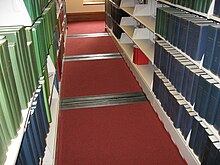Volume (bibliography)


A volume is a physical book. It may be printed or handwritten. The term is commonly used to identify a single book that is part of a larger collection. Volumes are typically identified sequentially with Roman or Arabic numerals, e.g. "volume III" or "volume 3", commonly abbreviated to "Vol.".[1]
Volumes may be published directly, or they may be created out of multiple bound issues. For instance, a library that subscribes to a periodical and wishes to preserve it typically takes a set of the issues and has them bound into a volume.[2][3] A publisher may also separately publish a volume out of previously published issues; this is common with graphic novels. A volume may also be composed of entries, as in an encyclopedia, or chapters, as in a monograph.
The term is also used as an identifier for a sequence of periodicals. This is generally based on a single calendar year, but not always. For instance, a school magazine might start each new volume at the beginning of the academic year or at the beginning of each term/semester. Likewise, a journal may start new volumes for each anniversary after its original inception. Thus, all issues published in the Nth term or year will be classified under the Nth volume.[1] The original function of labelling issues with a volume at publication time was to provide a standard way for libraries to later bind the issues into a physical volume.[2][3]
A part (commonly abbreviated to "Pt.") can be a special sub-division of a volume or it can be the highest level division of a journal. Parts are often designated with letters or names, e.g. "B", "Supplement".[4]
See also
[edit]References
[edit]- ^ a b Woodard, Beth, ed. (2002-10-29). "Journalism (newspapers/magazines): volume and issue". Questions and Answers. All Experts. About, Inc. Archived from the original on 2010-02-02. Retrieved 2012-11-06.
- ^ a b Bunn, Rosemary M. (1962-01-01). "Binding of Periodicals in the National Lending Library". Journal of Documentation. 18 (1). MCB UP Ltd: 20–24. doi:10.1108/eb026312. ISSN 0022-0418.
- ^ a b Ditzion, Sidney; Norman, Leverett (Winter 1956). "Problems of Periodical and Serial Binding" (PDF). Conservation of Library Materials. Library Trends. 4 (3). Graduate School of Library and Information Science, University of Illinois at Urbana-Champaign: 248–258. hdl:2142/5657. ISSN 0024-2594. S2CID 193321308. Archived (PDF) from the original on 2020-11-30. Retrieved 2021-07-30. (11 pages)
- ^ Hellman, Eric, ed. (2009-06-16) [2005-03-22]. "Brief guide to Implementing OpenURL 1.0 Context Object for Journal Articles". OpenURL COinS: A Convention to Embed Bibliographic Metadata in HTML. 1.0 (stable ed.). New Jersey, US: OCLC. Archived from the original on 2016-11-30. Retrieved 2016-11-30.
rft.part […] Part can be a special subdivision of a volume or it can be the highest level division of the journal. Parts are often designated with letters or names, i.e. "B", "Supplement".


 French
French Deutsch
Deutsch